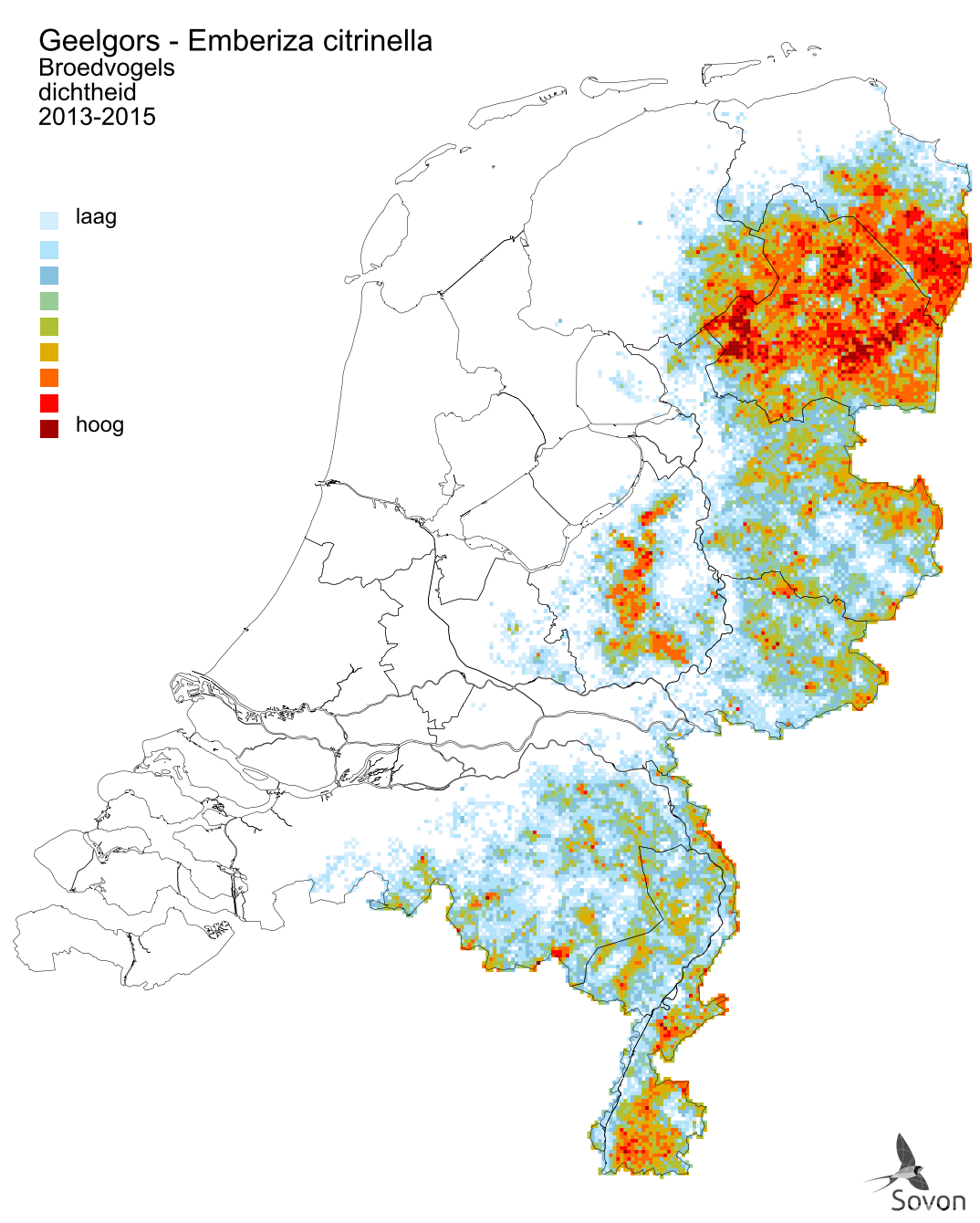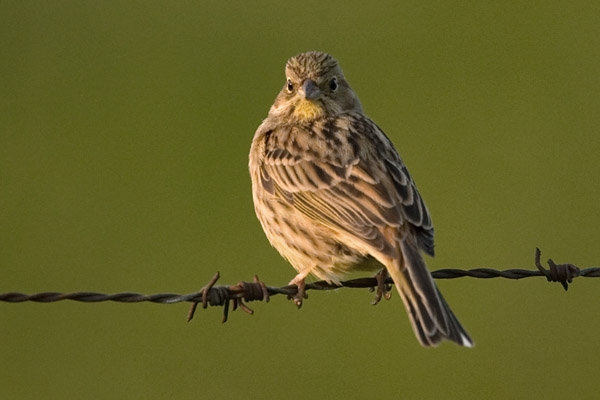Verspreiding en trends
Verspreiding

Deze kaart is gebaseerd op de Vogelatlas van Nederland (Sovon 2018). Weergegeven is de relatieve dichtheid per vierkante kilometer.

Deze kaart is gebaseerd op het Punt Transect Tellingen project (PTT). Weergegeven is het gemiddeld aantal exemplaren per telroute. Routes waar de soort niet is waargenomen zijn apart aangegeven (geen landelijke dekking).
Aantalsontwikkeling
broedvogeltrend
Deze grafiek is gebaseerd op het Meetnet Broedvogels (BMP, MUS, MAS). Weergegeven is de jaarlijkse index van de broedpopulatie (rode punten) en de trendlijn (donker gekleurde lijn).
- vanaf 1990
- significante toename, <5% per jaar (+)
- laatste 12 jaar
- significante afname, <5% per jaar (-)
niet-broedvogeltrend
Deze grafiek is gebaseerd op het Punt Transect Tellingen project (PTT). Weergegeven is de jaarlijkse index van de winterpopulatie in december (rode punten), de trendlijn (donker gekleurde lijn) en het 95% betrouwbaarheidsinterval
- vanaf 1980
- geen significante aantalsverandering (0)
- laatste 12 jaar
- significante afname, <5% per jaar (-)
Broedsucces en overleving
Onvoldoende gegevens beschikbaar voor trendanalyse.
Seizoensvoorkomen
seizoenspatroon
Deze grafiek is gebaseerd op LiveAtlas. Weergegeven is de meldingsfrequentie per decade, gemiddeld over de laatste 5 jaren. De meldingsfrequentie is het percentage volledige lijstjes waarop de soort is geregistreerd.
Beschrijving voorkomen
Buiten broedtijd
De Nederlandse broedvogels blijven hoofdzakelijk in eigen land en vormen wintergroepen op voedselrijke plekken. In uitzonderlijke gevallen, zoals de voor de hamster ingerichte akkers in Zuid-Limburg, gaat het om vele honderden of zelfs meer. Doortrek van Scandinavische en Duitse vogels treedt alleen op bescheiden schaal op. De meeste trek vindt plaats in oktober en begin november. Van de voorjaarstrek is weinig te merken, het meest nog in februari en maart. Tijdens de trek en in de winter zijn Geelgorzen schaars ook te vinden buiten de broedgebieden.
Broedtijd
Geelgorzen broeden tegenwoordig vrijwel uitsluitend op de hoge zandgronden. Ze bewonen hier heide met opslag, bosranden en jonge aanplant, naast kleinschalig boerenland met veel akkers. De verspreiding kromp sinds ongeveer 1975 in oostelijke richting in. De soort is inmiddels verdwenen uit West-Nederland, waar hij lokaal nog een algemene broedvogel was tot halverwege de twintigste eeuw. Ook in Midden-Nederland en delen van de zandgronden namen de aantallen aanvankelijk af. Na de eeuwwisseling nam de Geelgors echter (sterk) toe in het noordoosten van het land, mede dankzij de aanleg van ingezaaide akkerranden waar voldoende wintervoedsel te vinden was.
Vogelrichtlijn
Staat van instandhouding
De Vogelrichtlijn richt zich op de instandhouding van alle natuurlijk in Europa in het wild levende vogelsoorten waaronder de Geelgors.
Dit betekent dat de EU-lidstaten maatregelen moeten nemen om de populaties van deze soorten op een niveau te houden of te brengen dat met name beantwoordt aan de ecologische, wetenschappelijke en culturele eisen. Daaronder wordt onder andere een gunstige staat van instandhouding verstaan. Het begrip Staat van instandhouding is zo ongeveer synoniem voor de mate van duurzaamheid of gezondheid van een populatie van een soort.
De Vogelrichtlijn verlangt van de lidstaten dat ze leefgebieden voor vogels in voldoende omvang en kwaliteit in stand houden, waaronder door de aanwijzing van speciale beschermingszones ten behoeve van het Europese Natura 2000-netwerk. Voor de Geelgors zijn in Nederland geen speciale beschermingszones aangewezen. De landelijke populatie moet zich wel op een gunstig niveau kunnen handhaven.
Methodiek voor de bepaling van de Staat van instandhouding van vogels
broedvogel
De Staat van Instandhouding van de Geelgors als broedvogel in Nederland is zeer ongunstig.
| Beoordeling Staat van Instandhouding | ||||
| Verspreiding | Populatie | Leefgebied | Toekomst | Eindoordeel |
| zeer ongunstig | zeer ongunstig | zeer ongunstig | zeer ongunstig | zeer ongunstig |
niet-broedvogel
De Staat van Instandhouding van de Geelgors als niet-broedvogel in Nederland is gunstig.
| Beoordeling Staat van Instandhouding | ||||
| Verspreiding | Populatie | Leefgebied | Toekomst | Eindoordeel |
| gunstig | gunstig | gunstig | gunstig | gunstig |
Aangewezen gebieden
Er zijn geen gebieden aangewezen voor deze soort.
Telrichtlijnen
Broedvogels
Methode
Territoriumkartering
Tijd van het jaar
Half maart t/m eind juli
Tijd van de dag
Gehele ochtend, met kleine opleving in namiddag en avond. Bij koel weer later in de ochtend beter zingend dan rond zonsopkomst.
Datumgrenzen, normbezoeken en fusieafstand
| geldige waarnemingen | normbezoeken | minimaal vereist | fusie- | |||||||||
| adult | paar | terr | nest | migrant | 1 | 2 | 3 | seizoen | datumg | datumgrens | afstand | |
| . | X | X | X | 1-9 | 10-14 | 15+ | 1 | 20-3 t/m 15-7 | 300 | |||
Aanwijzingen
Zang [broedcode 2] (vanuit struik, boomtop of andere hogere zitplaats), alarm [brc 7] (geagiteerde vogel, opgezette kopveren, druk roepend of juist alleen hoog slepend piepje voortbrengend), nestbouw [brc 9] (door vrouwtje, mannetje altijd in de nabijheid) en transport van voedsel [brc 14] (mannetje voert broedend vrouwtje, beide partners voeren jongen) en ontlastingspakketjes [brc 14] (beide partners).
LET OP: foerageerplek kan buiten territorium liggen, partners vliegen er meestal samen naartoe.
Bijzonderheden
Weinig van doortrek in voorjaar te merken, maar bij waarnemingen buiten de hoge zandgronden is extra aandacht nodig. Vrouwtje is voorafgaand aan de eileg bijzonder agressief tegen mannetje. Interpreteer conflicten dus niet per definitie als territoriumconflicten. In heidegebieden valt de zangpiek vaak later dan in agrarische landschappen. Het is onbekend (maar gezien de plaatstrouw van de soort niet aannemelijk) of het hier om verplaatsingen in verband met 2e broedsels gaat.
Broedbiologie
Broedt in halfopen droge landschappen, vooral in heide met opslag en agrarisch cultuurlandschap met veel landschapselementen, ook wel in bos (aanplant, kaalslag). Nestelt zowel op de grond (greppel, onder heg etc.) als in struik of jonge boom. Eileg van half april tot begin augustus, piek in mei-juni. Twee tot drie broedsels per jaar, meestal 3-6 eieren, broedduur 11-14 dagen, nestjongenperiode 10-14 dagen.
